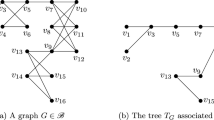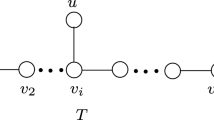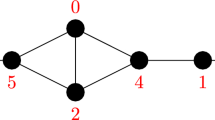Abstract
This paper presents “oriented pivoting systems” as an abstract framework for complementary pivoting. It gives a unified simple proof that the endpoints of complementary pivoting paths have opposite sign. A special case are the Nash equilibria of a bimatrix game at the ends of Lemke–Howson paths, which have opposite index. For Euler complexes or “oiks”, an orientation is defined which extends the known concept of oriented abstract simplicial manifolds. Ordered “room partitions” for a family of oriented oiks come in pairs of opposite sign. For an oriented oik of even dimension, this sign property holds also for unordered room partitions. In the case of a two-dimensional oik, these are perfect matchings of an Euler graph, with the sign as defined for Pfaffian orientations of graphs. A near-linear time algorithm is given for the following problem: given a graph with an Eulerian orientation with a perfect matching, find another perfect matching of opposite sign. In contrast, the complementary pivoting algorithm for this problem may be exponential.


Similar content being viewed by others
References
Balthasar, A.V.: Geometry and Equilibria in Bimatrix Games. PhD Thesis, London School of Economics (2009)
Casetti, M.M., Merschen, J., von Stengel, B.: Finding Gale strings. Electron. Notes Discret. Math. 36, 1065–1072 (2010)
Cayley, A.: Sur les déterminants gauches. Journal für die reine und angewandte Mathematik (Crelle’s Journal) 38, 93–96 (1849)
Chen, X., Deng, X.: Settling the complexity of two-player Nash equilibrium. In: Proceedings of 47th FOCS, pp. 261–272 (2006)
Cormen, T.H., Leiserson, C.E., Rivest, R.L., Stein, C.: Introduction to Algorithms, 2nd edn. MIT Press, Cambridge, MA (2001)
Cottle, R.W., Dantzig, G.B.: A generalization of the linear complementarity problem. J. Comb. Theory 8, 79–90 (1970)
Cottle, R.W., Pang, J.-S., Stone, R.E.: The Linear Complementarity Problem. Academic Press, San Diego (1992)
Daskalakis, C., Goldberg, P.W., Papadimitriou, C.H.: The complexity of computing a Nash equilibrium. SIAM J. Comput. 39, 195–259 (2009)
Eaves, B.C., Scarf, H.: The solution of systems of piecewise linear equations. Math. Oper. Res. 1, 1–27 (1976)
Edmonds, J.: Paths, trees, and flowers. Can. J. Math. 17, 449–467 (1965)
Edmonds, J.: Euler complexes. In: Cook, W., Lovasz, L., Vygen, J. (eds.) Research Trends in Combinatorial Optimization, pp. 65–68. Springer, Berlin (2009)
Edmonds, J., Gaubert, S., Gurvich, V.: Sperner oiks. Electron. Notes Discret. Math. 36, 1273–1280 (2010)
Gale, D.: Neighborly and cyclic polytopes. In: Klee, V. (ed.) Convexity, Proceedings of Symposia in Pure Math., Vol. 7, pp. 225–232. American Math. Soc., Providence, RI (1963)
Grigni, M.: A Sperner lemma complete for PPA. Inf. Process. Lett. 77, 255–259 (2001)
Hilton, P.J., Wylie, S.: Homology Theory: An Introduction to Algebraic Topology. Cambridge University Press, Cambridge (1967)
Jacobi, C.G.J.: Ueber die Pfaffsche Methode, eine gewöhnliche lineäre Differentialgleichung zwischen \(2n\) Variabeln durch ein System von \(n\) Gleichungen zu integriren. Journal für die reine und angewandte Mathematik (Crelle’s Journal) 2, 347–357 (1827)
Lax, P.D.: Linear Algebra and Its Applications. Wiley, Hoboken, NJ (2007)
Lemke, C.E.: Bimatrix equilibrium points and mathematical programming. Manag. Sci. 11, 681–689 (1965)
Lemke, C.E., Grotzinger, S.J.: On generalizing Shapley’s index theory to labelled pseudomanifolds. Math. Program. 10, 245–262 (1976)
Lemke, C.E., Howson Jr, J.T.: Equilibrium points of bimatrix games. J. Soc. Ind. Appl. Math. 12, 413–423 (1964)
Lovász, L., Plummer, M.D.: Matching Theory. North-Holland, Amsterdam (1986)
McLennan, A., Tourky, R.: Simple complexity from imitation games. Games Econ. Behav. 68, 683–688 (2010)
Merschen, J. : Nash Equilibria, Gale Strings, and Perfect Matchings. PhD Thesis, London School of Economics (2012)
Morris Jr, W.D.: Lemke paths on simple polytopes. Math. Oper. Res. 19, 780–789 (1994)
Papadimitriou, C.H.: On the complexity of the parity argument and other inefficient proofs of existence. J. Comput. Syst. Sci. 48, 498–532 (1994)
Parameswaran, S.: Skew–symmetric determinants. Am. Math. Mon. 61, 116 (1954)
Robertson, N., Seymour, P.D., Thomas, R.: Permanents, Pfaffian orientations, and even directed circuits. Ann. Math. 150, 929–975 (1999)
Savani, R., von Stengel, B.: Hard-to-solve bimatrix games. Econometrica 74, 397–429 (2006)
Shapley, L.S.: A note on the Lemke–Howson algorithm. In: Mathematical Programming Study 1: Pivoting and Extensions, pp. 175–189 (1974)
Tarjan, R.E.: Efficiency of a good but not linear set union algorithm. J. ACM 22, 215–225 (1975)
Thomas, R.: A survey of Pfaffian orientations of graphs. In: Proceedings of International Congress of Mathematicians, Madrid, Spain, Vol. III, pp. 963–984. European Mathematical Society, Zürich (2006)
Todd, M.J.: Abstract Complementary Pivot Theory. PhD Dissertation, Yale University (1972)
Todd, M.J.: A generalized complementary pivot algorithm. Math. Program. 6, 243–263 (1974)
Todd, M.J.: Orientation in complementary pivot algorithms. Math. Oper. Res. 1, 54–66 (1976)
Valiant, L.G.: The complexity of computing the permanent. Theoret. Comput. Sci. 8, 189–201 (1979)
Vazirani, V.V., Yannakakis, M.: Pfaffian orientations, 0–1 permanents, and even cycles in directed graphs. Discret. Appl. Math. 25, 179–190 (1989)
Végh, L.A., von Stengel, B.: Oriented Euler complexes and signed perfect matchings. arXiv:1210.4694 (2012)
von Stengel, B.: New maximal numbers of equilibria in bimatrix games. Discret. Comput. Geom. 21, 557–568 (1999)
von Stengel, B.: Computing equilibria for two-person games. In: Aumann, R.J., Hart, S. (eds.) Handbook of Game Theory, vol. 3, pp. 1723–1759. North-Holland, Amsterdam (2002)
Ziegler, G.M.: Lectures on Polytopes. Springer, New York (1995)
Acknowledgments
We thank Marta Maria Casetti and Julian Merschen for stimulating discussions during our joint research on labeled Gale strings and perfect matchings, which led to the questions answered in this paper. We also thank three anonymous referees for their helpful comments.
Author information
Authors and Affiliations
Corresponding author
Rights and permissions
About this article
Cite this article
Végh, L.A., von Stengel, B. Oriented Euler complexes and signed perfect matchings. Math. Program. 150, 153–178 (2015). https://doi.org/10.1007/s10107-014-0770-4
Received:
Accepted:
Published:
Issue Date:
DOI: https://doi.org/10.1007/s10107-014-0770-4
Keywords
- Complementary pivoting
- Euler complex
- Linear complementarity problem
- Nash equilibrium
- Perfect matching
- Pfaffian orientation
- PPAD




